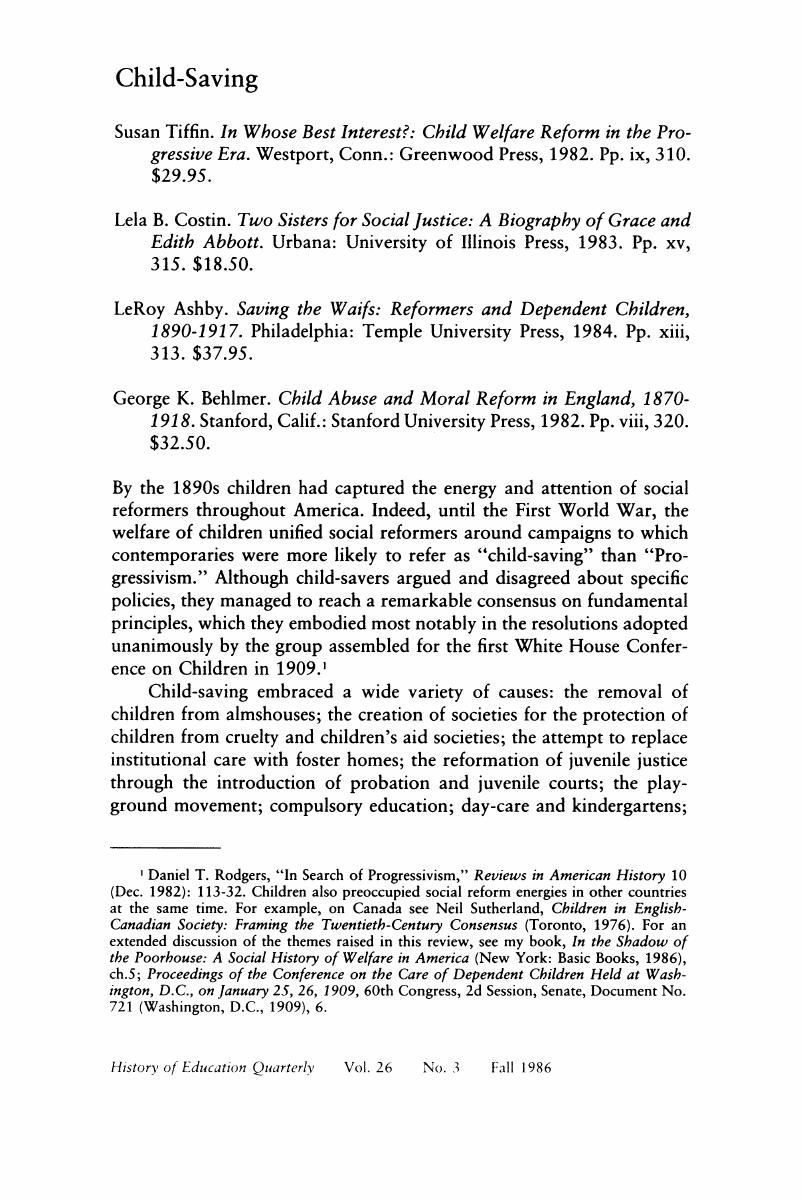Article contents
Child-Saving
Published online by Cambridge University Press: 24 February 2017
Abstract

- Type
- Essay Reviews
- Information
- Copyright
- Copyright © 1986 by the History of Education Society
References
1. Rodgers, Daniel T., “In Search of Progressivism,” Reviews in American History 10 (Dec. 1982): 113–32. Children also preoccupied social reform energies in other countries at the same time. For example, on Canada see Sutherland, Neil, Children in English-Canadian Society: Framing the Twentieth-Century Consensus (Toronto, 1976). For an extended discussion of the themes raised in this review, see my book, In the Shadow of the Poorhouse: A Social History of Welfare in America (New York: Basic Books, 1986), ch.5; Proceedings of the Conference on the Care of Dependent Children Held at Washington, D.C., on January 25, 26, 1909, 60th Congress, 2d Session, Senate, Document No. 721 (Washington, D.C., 1909), 6.CrossRefGoogle Scholar
2. Trattner, Walter I., Homer Folks: Pioneer in Social Welfare (New York, 1968); Trattner, Walter I., Crusade for the Children: A History of the National Child Labor Committee and Child Labor Reform in America (Chicago, 1970). For Folks's own views, see his The Care of Destitute, Neglected, and Delinquent Children (New York, 1902; reprinted 1978). A particularly eloquent and vivid manifesto of the child-saving movement is, Spargo, John, The Bitter Cry of the Children, ed. Trattner, Walter I. (New York, 1906; Quadrangle/New York Times edition, 1968).Google Scholar
3. Tiffin, Susan, In Whose Best Interest?: Child Welfare Reform in the Progressive Era (Westport, Conn., 1982).Google Scholar
4. Costin, Lela B., Two Sisters for Social Justice: A Biography of Grace and Edith Abbott (Urbana, Ill., 1983).Google Scholar
5. On Sheppard-Towner, see Rothman, Sheila M., Women's Proper Place: A History of Changing Ideals and Practices, 1870 to the Present (New York, 1978), 135–53.Google Scholar
6. Folks, Homer, “What Brought about the New York System? Do These Reasons Still Exist?” Proceedings of the New York State Conference of Charities and Corrections, First Annual Session, November 20, 21, and 22, 1900, ed. Barrows, Isabel C. (Albany, N.Y., 1901), 133.Google Scholar
7. Lasch, Christopher, Haven in a Heartless World: The Family Besieged (New York, 1979).CrossRefGoogle Scholar
8. Cavallo, Dominick, Muscles and Morals: Organized Playgrounds and Urban Reform, 1880–1920 (Philadelphia, 1981), xi, 15.Google Scholar
9. Behlmer, George K., Child Abuse and Moral Reform in England, 1870–1908 (Stanford, Calif., 1982), 202.Google Scholar
10. Behlmer, , Child Abuse, passim.Google Scholar
11. Cavallo, , Muscles and Morals, 46.Google Scholar
12. Schlossman, Steven L., Love and the American Delinquent: The Theory and Practice of “Progressive” Juvenile Justice, 1825–1920 (Chicago, 1976), 188.Google Scholar
13. Rothman, David J., Conscience and Convenience: The Asylum and Its Alternatives in Progressive America (Boston, 1980).CrossRefGoogle Scholar
14. Norton Grubb, W. and Lazerson, Marvin, Broken Promises: How Americans Fail Their Children (New York, 1982), esp. 247, 279, 283–84.Google Scholar
15. Trattner, , Homer Folks, 154–55 and 214–15; Leavitt, Judith Walzer, The Healthiest City: Milwaukee and the Politics of Health Reform (Princeton, N.J., 1982), 38–39, 214; Josephine Baker, S., Fighting for Life (New York, 1939), 253; Condran, Gretchen A., Williams, Henry, and Cheney, Rose A., “The Decline in Mortality in Philadelphia from 1870 to 1930: The Role of Municipal Services,” Pennsylvania Magazine of History and Biography 108 (Apr. 1984): 153–77.Google Scholar
16. Leavitt, , Healthiest City, 70.Google Scholar
17. Ashby, LeRoy, Saving the Waifs: Reformers and Dependent Children, 1890–1917 (Philadelphia, 1984), 13.Google Scholar
18. Ashby, Saving the Waifs, 5. This interpretation conflicts with Paul Boyer's which stresses the secularization of philanthropy in the late nineteenth century. Boyer, Paul S., Urban Masses and Moral Order in America, 1820–1920 (Cambridge, Mass., 1978), 167–68.Google Scholar
19. Ashby, , Saving the Waifs, 69–205.Google Scholar
20. Tiffin, , In Whose Best Interest?, 205–10.Google Scholar
21. Ibid., 130. For a summary of the arguments for and against mothers' pensions, see Bullock, Edna D., comp., Selected Articles on Mothers' Pensions (White Plains and New York, 1925).Google Scholar
22. White House Conference, Proceedings, 89. On changes in child psychology, see Cavallo, , Muscles and Morals, 49–50.Google Scholar
23. Zelizer, Viviana A., Pricing the Priceless Child: The Changing Social Value of Children (New York, 1985), 3–6.Google Scholar
24. In a fascinating last chapter, Zelizer points out that only as women have begun to reenter the labor force in large numbers and to reject the doctrines of domesticity and separate spheres has the ideal of the priceless (and useless) child begun to crumble. She speculates that a new version of the “useful” child, expected to help with domestic tasks and share responsibility, may be emerging. Zelizer, , Pricing the Priceless Child, 208–28.Google Scholar
- 2
- Cited by




